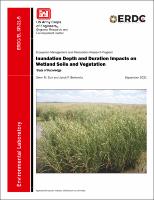Please use this identifier to cite or link to this item:
https://hdl.handle.net/11681/42146Full metadata record
| DC Field | Value | Language |
|---|---|---|
| dc.contributor.author | Suir, Glenn M. | - |
| dc.contributor.author | Berkowitz, Jacob F., 1979- | - |
| dc.date.accessioned | 2021-09-29T14:56:20Z | - |
| dc.date.available | 2021-09-29T14:56:20Z | - |
| dc.date.issued | 2021-09 | - |
| dc.identifier.govdoc | ERDC/EL SR-21-5 | - |
| dc.identifier.uri | https://hdl.handle.net/11681/42146 | - |
| dc.identifier.uri | http://dx.doi.org/10.21079/11681/42146 | - |
| dc.description | Special Report | en_US |
| dc.description.abstract | The following synthesizes studies investigating plant and soil responses to increased inundation in order to support ecosystem restoration efforts related to the alteration of natural wetland hydrodynamics. Specific topics include hydrologic regimes, soil response to inundation, and implications for vegetation communities exposed to increased water depths. Results highlight the important interactions between water, soils, and vegetation that determine the trajectory and fate of wetland ecosystems, including the development of feedback loops related to marsh degradation and subsidence. This report then discusses the knowledge gaps related to implications of inundation depth, timing, and duration within an ecosystem restoration context, identifying opportunities for future research while providing source materials for practitioners developing restoration projects. | en_US |
| dc.description.sponsorship | Ecosystem Management and Restoration Research Program (U.S.) | en_US |
| dc.description.tableofcontents | Abstract .................................................................................................................................... ii Preface ..................................................................................................................................... vi 1 Introduction ...................................................................................................................... 1 1.1 Background .................................................................................................................... 1 1.2 Objective ........................................................................................................................ 1 1.3 Approach ........................................................................................................................ 2 2 Review of Inundation-Related Impacts on Soil and Vegetation Processes .............. 3 2.1 Hydrologic processes .......................................................................................................3 2.1.1 Hydrologic regime .......................................................................................... 3 2.1.2 Plant and soil processes ............................................................................... 4 2.1.3 Inundation events—natural and anthropogenic effects .............................. 5 2.1.4 Negative impacts of increased inundation .................................................. 7 2.1.5 Plant response and adaptations ................................................................... 8 2.2 Soils studies .................................................................................................................. 10 2.2.1 Implications of increased inundation on wetland soils ............................. 10 2.2.2 Defining wetland soils and identifying them in the field ........................... 11 2.2.3 Using soil maps to identify wetland soil areas ........................................... 12 2.2.4 Wetland soil morphology ............................................................................. 17 2.2.5 Wetland soil taxonomy ................................................................................. 21 2.2.6 Wetland soil hydroperiods and hydropatterns ........................................... 24 2.2.7 Wetland soil responses to changes in hydropattern .................................. 26 2.2.8 Response of wetland soils to inundation ................................................... 31 2.2.9 Knowledge gaps in soil inundation research ............................................. 35 2.3 Vegetation studies ........................................................................................................ 36 2.3.1 Implications of increased inundation on wetland plants .......................... 36 2.3.2 Flooding impacts on foundational plants ................................................... 37 2.3.3 Knowledge gaps in plant inundation research .......................................... 52 3 Summary and Conclusion ............................................................................................. 53 References ............................................................................................................................. 54 Report Documentation Page | - |
| dc.format.extent | 85 pages / 5.33 MB | - |
| dc.format.medium | - | |
| dc.language.iso | en_US | en_US |
| dc.publisher | Environmental Laboratory (U.S.) | en_US |
| dc.publisher | Engineer Research and Development Center (U.S.) | - |
| dc.relation.ispartofseries | Special Report (Engineer Research and Development Center (U.S.)) ; no. ERDC/EL SR-21-5 | - |
| dc.rights | Approved for Public Release; Distribution is Unlimited | - |
| dc.source | This Digital Resource was created in Microsoft Word and Adobe Acrobat | - |
| dc.subject | Wetlands--Soils | en_US |
| dc.subject | Wetlands--Plants | en_US |
| dc.subject | Floods | en_US |
| dc.subject | Restoration ecology | en_US |
| dc.subject | Wetland restoration | en_US |
| dc.title | Inundation depth and duration impacts on wetland soils and vegetation : state of knowledge | en_US |
| dc.type | Report | en_US |
| Appears in Collections: | Special Report | |
Files in This Item:
| File | Description | Size | Format | |
|---|---|---|---|---|
| ERDC-EL SR-21-5.pdf | 5.33 MB | Adobe PDF |  View/Open |